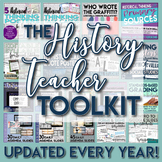Historical Thinking Skills Introduction Solve a School Mystery!
- Zip
What educators are saying
Also included in
- Give yourself an easier start in the back-to-school season! This History Teacher Toolkit included the major materials you'll need to start your school year. I've made sure to include almost everything (with more coming), to put you at ease, and allow you to focus on the more important part of your cPrice $28.95Original Price $56.10Save $27.15
Description
Struggling with making historical thinking skills easy and accessible to your students? This introductory activity makes the skills relatable and fun!
With this activity, students will be introduced to the major historical thinking skills (historical context, point of view, purpose, audience, and sourcing) without requiring them to also analyze historical information. The situation involves a girl named Gabby. Someone has written graffiti on the school wall about Gabby, and no one knows who!
With no cameras facing that location, the assistant principal (played by your students) will have to investigate the 5 possible culprits seen in the area. Students will then write a referral where they use the evidence collected to place blame. All of the profiles are written in a way so that anyone could be found guilty if argued in the right way. Therefore, this activity will lead to a bunch of fun debate.
These is a perfect back to school activity. The best part is that you can refer back to this lesson throughout the school year. When students forget what "point of view" means, you can refer back to this story.
The digital version is similar, however, I've created a digital Google Slides version of the graphic organizer that can be shared with students to edit in groups.
NOTE: The story involves Gabby sneaking out of her house to meet up with a boy named Josh. As noted in the profile of Gabby, the students just meet to talk. It’s very PG rated, however, I thought I would make the plot line clear if you work in a really restrictive district.
Included within this resource:
● A PowerPoint version of the product (editable)
● A PDF version of the product (not editable)
● A Google Slides Version of the document (The link provided will prompt you to make your own file. You can then add that file to your drive and share with your students. This version is also editable.)
● A lesson plan to help with implementation
------------------------------------------------------------------------------------------------------
Tips for Customers:
Follow my store to be the first to know when I launch new products. Simply click the little green star next to my name, and my new products will appear on the front page of your TPT account.
Did you know you can earn TPT credit towards future purchases?
Make sure you’re logged into your account and find your My Purchases page. For each purchase you’ve made, make sure to leave feedback. This feedback earns you credit towards future purchases - it’s like free TPT money! Feedback is very important to me, as it helps me to create new products. If you have any questions regarding a TPT product you’ve purchased from me, simply e-mail me at peacefieldblog@gmail.com
You can find more Social Studies resources, links, and discussion at my blog - peacefieldhistory.com.





